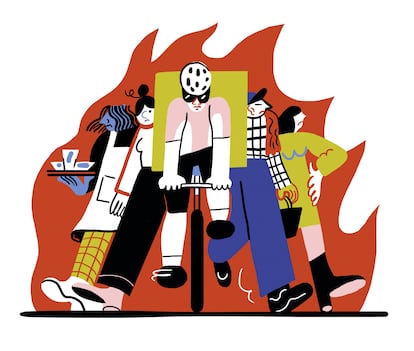Strength in unity: union mobilization is on the rise among young people, and in new and precarious job sectors
From Hollywood screenwriters to Spanish hotel workers, new spaces of collective struggle for labor rights are opening up

The topic has been trending on social media and catching the attention of experts like Nicholas Kristof, in a recent The New York Times column, or Lydia Saad, in her Gallup digital newsletter. Major union mobilizations — that Jurassic beast on the cusp of extinction since the end of the 20th century — are experiencing an unexpected upturn in the aftermath of the pandemic. In recent months, we have seen the sitting president of the United States join a picket line against the Big Three in Detroit; Hollywood studios taking a knee after a 145-day strike led by the screenwriters’ union and backed by the actors; French unions engaged in a prolific struggle against their government; and riders and other precarious employees of digitized and disruptive companies, organizing for the first time to improve their working conditions. Even the members of Spain’s national women’s soccer team have turning to a union, Futpro, to coordinate efforts in their struggle with the Spanish Federation.
Kristof says that picket lines like those in Detroit, traditionally accused of destroying the auto industry with their stubborn blindness, are now winning recognition as a powerful tool in the fight for fairness, the only thing preventing lower-skilled workers from being “treated as doormats.” Saad offers a fact: 67% of Americans consider union action “necessary and positive,” a number that contrasts with the meager 48% approval rating recorded in 2010, or the 56% in 2016.
In Spain, according to figures provided by Beltrán Roca, a professor of sociology at the University of Cadiz, “membership remains stagnant at around 13%-14%, but at least it has stopped falling, and the social perception of labor demands is improving,” which means “we are facing a positive turning point and beginning to leave behind the trend of increasing demobilization seen over the last 25 years.” Roca attributes this to a confluence of different phenomena, such as “inflation, rising housing prices and the rapid growth in new production processes and new labor sectors.” In this context of “accelerating change and increasing precariousness,” workers are feeling the need to “start from scratch and resort to new strategies for negotiating collective and sector-wide agreements.” In Beltrán’s opinion, this represents a “solid” trend both in Spain and worldwide. “It’s happening in almost all major Western economies.”
For sociologist and political scientist Antonio Antón, professor at the Autonomous University of Madrid, “there are symptoms of union reactivation” that affect, above all, “new groups of workers, especially in the service sector and among women and younger workers.” Antón specifies that this rejuvenated and feminized trade unionism “has some characteristics that are different than the conventional trade union action of the industrial working class and large companies.” The new mobilizations are “less institutional.” They are “grassroots” movements with a “notable capacity for public contestation.” On occasion, “as has happened in Spain with the wave of educational and health-worker mobilizations, they have seen large-scale participation and have aroused broad solidarity and sympathy in society as a whole.”
Lis Gaibar, an associate professor at Miguel Hernández University and an expert on workers’ associations, says there is an upturn, forced by circumstances, of “collectivism or associationism, but not necessarily of trade unionism.” This is due to the fact that the most novel and compelling mobilizations, like those of “domestic workers, maids or riders,” are being promoted by associations, not unions. In other words, we are witnessing a mobilization against systematic labor abuse led by the victims of precariousness and the associations that support them. The main agents of this collective action are “young people for whom the labor market does not offer the possibility of building a life project that matches their aspirations.” Their frustration produces “a confrontational attitude” that is very rarely channeled through traditional trade unions.
For Gaibar, new generations are bringing new lifeblood into the labor movement. In particular, “a dose of weariness and a greater ability to see the cracks in a system that for years had been able to hide them.” Beltrán Roca adds that the future of collective mobilization involves, in his opinion, “creating new structures to combat the vacuum of representation, which is what is lacking among most precarious workers in small companies, such as those in the hotel and catering industry — jobs that are not unionized and where sector agreements are not respected.” The solution is to “create structures of union representation at an intermediate level, such as the municipal committees that are beginning to proliferate in the United Kingdom.” The old recipe — unity is strength — must give way to “less rigid strategies, more flexible and adapted to the specific circumstances of each sector, in order to channel discontent and continue to be effective.”
Sign up for our weekly newsletter to get more English-language news coverage from EL PAÍS USA Edition
Tu suscripción se está usando en otro dispositivo
¿Quieres añadir otro usuario a tu suscripción?
Si continúas leyendo en este dispositivo, no se podrá leer en el otro.
FlechaTu suscripción se está usando en otro dispositivo y solo puedes acceder a EL PAÍS desde un dispositivo a la vez.
Si quieres compartir tu cuenta, cambia tu suscripción a la modalidad Premium, así podrás añadir otro usuario. Cada uno accederá con su propia cuenta de email, lo que os permitirá personalizar vuestra experiencia en EL PAÍS.
¿Tienes una suscripción de empresa? Accede aquí para contratar más cuentas.
En el caso de no saber quién está usando tu cuenta, te recomendamos cambiar tu contraseña aquí.
Si decides continuar compartiendo tu cuenta, este mensaje se mostrará en tu dispositivo y en el de la otra persona que está usando tu cuenta de forma indefinida, afectando a tu experiencia de lectura. Puedes consultar aquí los términos y condiciones de la suscripción digital.
More information
Archived In
Últimas noticias
Welcome to the post-religion era: The idea of Christianity as the absolute truth has become obsolete
‘I thought you would like it’: The risky sexual practice popularized by TV shows and TikTok
The digitalization of tourism: ‘They promise experiences and gave us the worst possible one’
Mexican peso defies uncertainty with forecasts of a new period of stability in 2026
Most viewed
- Sinaloa Cartel war is taking its toll on Los Chapitos
- Oona Chaplin: ‘I told James Cameron that I was living in a treehouse and starting a permaculture project with a friend’
- Reinhard Genzel, Nobel laureate in physics: ‘One-minute videos will never give you the truth’
- Why the price of coffee has skyrocketed: from Brazilian plantations to specialty coffee houses
- Silver prices are going crazy: This is what’s fueling the rally











































